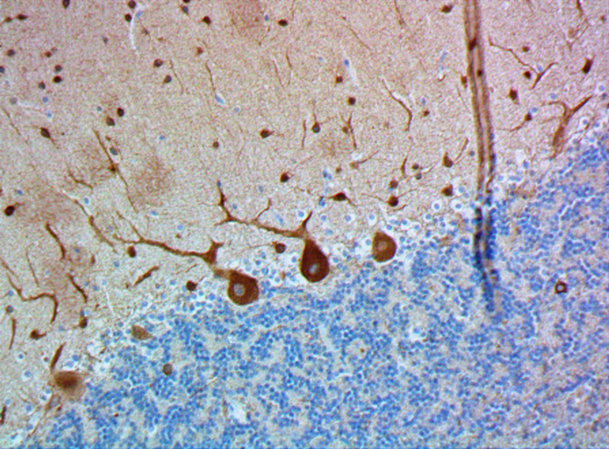- Clone
- Poly28225 (See other available formats)
- Regulatory Status
- RUO
- Other Names
- Microtubule-associated protein 2, MAP-2
- Previously
-
Covance Catalog# PCK-554P
- Isotype
- Chicken IgY
- Ave. Rating
- Submit a Review
- Product Citations
- publications

-

Immunohistochemical staining of MAP2 Chicken Polyclonal Antibody, on formalin fixed paraffin embedded mouse brain tissue at 1/10,000 dilution.
| Cat # | Size | Price | Quantity Check Availability | Save | ||
|---|---|---|---|---|---|---|
| 822501 | 50 µL | £257 | ||||
Microtubules are 25nm diameter protein rods found in most kinds of eukaryote cells. They are polymerized from a dimeric subunit made of one α subunit and one β tubulin subunit. Microtubules are associated with a family of proteins called microtubule associated proteins (MAPs), which includes the protein τ (tau) and a group of proteins referred to as MAP1, MAP2, MAP3, MAP4 and MAP5. MAP2 is made up of two ~280kD apparent molecular weight bands referred to as MAP2a and MAP2b. A third lower molecular weight form, usually called MAP2c, corresponds to a pair of protein bands running at ~70 kD on SDS-PAGE gels. All these MAP2 forms are derived from a single gene by alternative transcription, and all share a C-terminal sequence which includes either three or four microtubule binding peptide sequences, which are very similar to those found in the related microtubule binding protein τ (tau). MAP2 isoforms are expressed only in neuronal cells and specifically in the perikarya and dendrites of these cells. Antibodies to MAP2 are therefore excellent markers on neuronal cells, their perikarya and neuronal dendrites. In contrast τ (tau) is found predominantly in neuronal axons.
Product DetailsProduct Details
- Verified Reactivity
- Mouse
- Reported Reactivity
- Human, Rat, Cow
- Antibody Type
- Polyclonal
- Host Species
- Chicken
- Immunogen
- This antibody was made against MAP2 in chickens.
- Preparation
- The antibody was purified by affinity chromatography.
- Concentration
- Lot-specific (to obtain lot-specific concentration and expiration, please enter the lot number in our Certificate of Analysis online tool.)
- Storage & Handling
- The antibody solution should be stored undiluted between 2°C and 8°C. Please note the storage condition for this antibody has been changed from -20°C to between 2°C and 8°C. You can also check your vial or your CoA to find the most accurate storage condition for this antibody.
- Application
-
IHC-P - Quality tested
WB - Recommended Usage
-
Each lot of this antibody is quality control tested by formalin-fixed paraffin-embedded immunohistochemical staining.
The optimal working dilution should be determined for each specific assay condition.
• WB: 1:100,000*
• IF: 1:10,000 - Application Notes
-
This antibody is effective in immunoblotting (WB) and immunofluorescence (IF). This antibody does not bind to protein A or protein G.
*Predicted MW = 280 kD and a doublet ~70 kD -
Application References
(PubMed link indicates BioLegend citation) -
- Savas JN, et al. 2010. J Biol Chem. 285:13142-53. [IF] PubMed
- Product Citations
-
- RRID
-
AB_2564858 (BioLegend Cat. No. 822501)
Antigen Details
- Cell Type
- Neural Stem Cells
- Biology Area
- Cell Biology, Neuroscience, Neuroscience Cell Markers, Stem Cells
- Molecular Family
- Microtubules
- Gene ID
- 4133 View all products for this Gene ID
- UniProt
- View information about MAP2 on UniProt.org
Related FAQs
Other Formats
View All MAP2 Reagents Request Custom Conjugation| Description | Clone | Applications |
|---|---|---|
| Purified anti-MAP2 | Poly28225 | IHC-P,WB |
Customers Also Purchased


Compare Data Across All Formats
This data display is provided for general comparisons between formats.
Your actual data may vary due to variations in samples, target cells, instruments and their settings, staining conditions, and other factors.
If you need assistance with selecting the best format contact our expert technical support team.
-
Purified anti-MAP2

Immunohistochemical staining of MAP2 Chicken Polyclonal Anti...
 Login / Register
Login / Register 









Follow Us